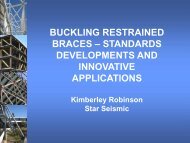Environmental Impacts of Multi-Storey Buildings Using Different ...
Environmental Impacts of Multi-Storey Buildings Using Different ...
Environmental Impacts of Multi-Storey Buildings Using Different ...
You also want an ePaper? Increase the reach of your titles
YUMPU automatically turns print PDFs into web optimized ePapers that Google loves.
- 9 -GlossaryCO 2 stored – refers to the CO 2 stored in non decomposed wood that has been disposed <strong>of</strong> inlandfill.Embodied energy – refers to the energy required to make a product, which includes: rawmaterial acquisition and processing, energy production, transport, and product manufacturing,i.e. “cradle to gate”.End <strong>of</strong> life energy – refers to the energy associated with the disposal <strong>of</strong> a material at the finalstages <strong>of</strong> the life cycle (e.g. landfilling or recycling) and includes the transport <strong>of</strong> materials tothe disposal/recycling facility. EOL may be positive or negative depending on the disposalmode. Examples <strong>of</strong> disposal modes include landfilling and combustion.Energy recovery – refers to obtaining useful energy from wood waste through combustion.Energy retained – refers to the total potential energy that could be produced fromcombustion <strong>of</strong> materials.GHG substitution – refers to the amount <strong>of</strong> fossil fuel GHG emissions unreleased, whenobtaining energy from wood instead <strong>of</strong> fossil fuel energy sources.Initial embodied energy – refers to the embodied energy <strong>of</strong> a building once it has beencompleted, before any maintenance has been undertaken.Maintenance (recurrent) related embodied energy – refers to the embodied energy <strong>of</strong>materials required to maintain the building.Material reutilisation – refers to reusing certain building materials for other beneficialpurposes, following deconstruction <strong>of</strong> the building. Examples include combustion <strong>of</strong> wood forenergy or recycling <strong>of</strong> materials.Operational energy – total primary energy consumed during the 60 year life <strong>of</strong> the building.Primary energy – Energy required to produce a unit <strong>of</strong> useful energy (MJ or kWh), whichincludes all upstream processes. Primary energy is energy contained in raw fuels and anyother forms <strong>of</strong> energy that has not been subjected to any conversion or transformationprocess. Primary energies are transformed in energy conversion processes to more convenientforms <strong>of</strong> energy, such as electrical energy and cleaner fuels.Total embodied energy – refers to the sum <strong>of</strong> initial embodied energy, maintenance relatedembodied energy, operational energy, end-<strong>of</strong>-life energy, and energy recovered throughmaterial reutilisation.Useful metered energy – Energy consumed at a point source, i.e. power socket.
















